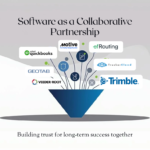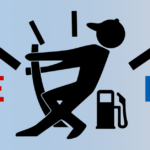In the fast-paced world of transportation and logistics, every mile, every delivery, and every drop of fuel counts. For fuel delivery trucking companies, efficiency isn’t just a goal, it’s the engine that drives profitability and customer satisfaction. As a Fuel Hauler, you know better than anyone that the entire industry is built on a foundation of partnerships, from suppliers to drivers, and ultimately, to your customers. So why should your essential software, your Transportation Management System (TMS), feel any different?
At TrueTMS, we believe your TMS should be more than just a tool; it should be a strategic partner. It’s not enough for a TMS to simply “connect” with other solutions. In today’s complex operational landscape, you need a system that truly integrates and collaborates with the best-in-class technologies, creating a seamless, unified, and intelligent ecosystem that propels your business forward. We’re talking about a breath of fresh air compared to the legacy solutions that often leave you patching together disparate systems.
The Problem with the Patchwork: Why Simple Connections Fall Short
Many TMS providers promise integration, and some even boast hundreds of partners. However, what they often deliver is merely visibility. They pull data from various sources into one screen, giving you a glimpse, but rarely offering true, automated functionality across platforms. This “patchwork” approach often leads to:
- Fragmented Workflows: Juggling multiple systems for different tasks, leading to manual data entry, errors, and wasted time.
- Limited Automation: The inability for different solutions to “talk” to each other in a meaningful way, hindering the potential for end-to-end automation.
- Data Silos: Important operational data remaining isolated within individual applications, making comprehensive analysis and strategic decision-making difficult.
- Scalability Challenges: As your business grows, adding more disconnected systems becomes an unmanageable headache, not a solution.
For a fuel delivery business, these challenges can translate directly into delayed deliveries, mismanaged inventory, and ultimately, lost revenue. You need a TMS that doesn’t just show you what’s happening; it helps make it happen, intelligently and automatically.
True Partnership: The TrueTMS Difference
At TrueTMS, we’ve built our philosophy around the power of true partnerships. We meticulously vet and collaborate with leading technology providers, not just to bring their solutions into ours for visibility, but to use their strengths to create a unique, unified, smart solution. While other TMS providers might brag about having hundreds of integration partners, our approach is different. We focus on quality over quantity because we’re not just merely connecting silos to remain a silo still. We integrate deeply, meaning:
- Deep, Bi-directional Integration: Our partnerships go beyond simple data feeds. We build robust connections that allow our TMS and our partners’ solutions to communicate seamlessly, sharing information and triggering actions in real-time.
- Automated Workflows: Imagine your accounting software automatically receiving billing information from your TMS, or your ELD data directly impacting dispatch decisions. True partnerships enable this level of automation, eliminating manual tasks and reducing human error.
- Enhanced Decision-Making: By unifying data from all critical operational areas, from routing and mileage to fuel levels and financial data, you gain a holistic view of your business, empowering you to make faster, more informed strategic decisions.
- Future-Proofing Your Operations: We continuously seek out the most meaningful, forward-thinking partners, ensuring that your TrueTMS solution evolves with the industry, keeping you ahead of the curve.
Vetting the Best: How to Choose Your TMS Partner Ecosystem
When evaluating a TMS, don’t just look at its features. Look at its partnerships. Here’s what to consider when vetting vendors and their partner ecosystems:
- Look Beyond the Logo: A long list of logos on a website doesn’t guarantee deep integration. Ask specific questions about how the solutions integrate. Is it a simple API call for data visibility, or is there a true bi-directional flow of information that enables automation?
- Focus on Your Core Operations: For fuel delivery, consider partners that directly impact your key operational areas. Do they have strong integrations with:
- Accounting/ERP Systems: (Like our partners QuickBooks and PetroleumRX) to ensure seamless financial management, invoicing, and payroll.
- Commercial Routing, Mileage & Mapping: (Such as our collaborations with Trimble Maps and PC*Miler) for accurate route optimization, mileage calculations, and driver navigation.
- ELD Solutions: (Like our integrations with GeoTAB and Motive) for compliance, driver safety, and hours of service management.
- Automatic Tank Gauge (ATG) Readings: (Leveraging partners like Veeder Root ATGs) for precise fuel inventory management and automatic dispatching based on real-time tank levels.
- Loadboard and Lane Analysis: (Through partners like efRouting) for optimizing backhauls, finding profitable loads, and understanding market dynamics.
- Assess the Depth of Integration: A truly integrated solution will eliminate redundant data entry and allow information to flow effortlessly between systems. Can you see how an order in your TMS will automatically create a corresponding entry in your accounting software, or how real-time fuel data from your ATGs can trigger dispatch alerts?
- Evaluate Partner Support and Reliability: Just like your TMS provider, their partners should offer robust support and have a proven track record of reliability. A chain is only as strong as its weakest link.
- Look for Innovation and Collaboration: Does the TMS provider actively work with their partners to develop new functionalities and improve existing integrations? TrueTMS is always striving to find the “best of the best” partners who are willing to collaborate on creating innovative, unified solutions.
The Future is Unified
In the demanding world of fuel delivery logistics, your TMS isn’t just software; it’s the central nervous system of your operation. By choosing a TMS that prioritizes true partnerships over mere connections, you’re investing in a future where your systems work together seamlessly, intelligently, and automatically. This isn’t just about efficiency; it’s about competitive advantage, streamlined operations, and ultimately, a more profitable and sustainable business.
Don’t settle for a patchwork. Demand a partnership. Demand a TMS that truly understands the power of collaboration.



